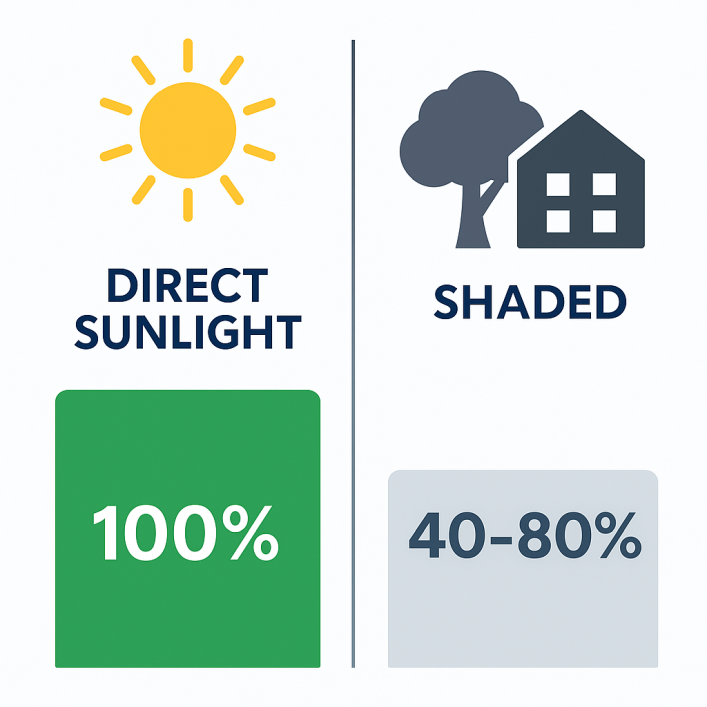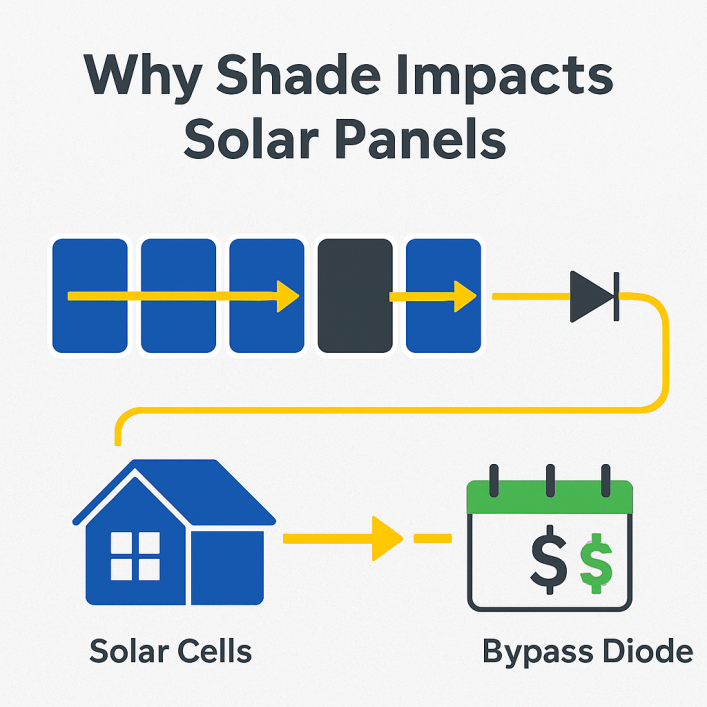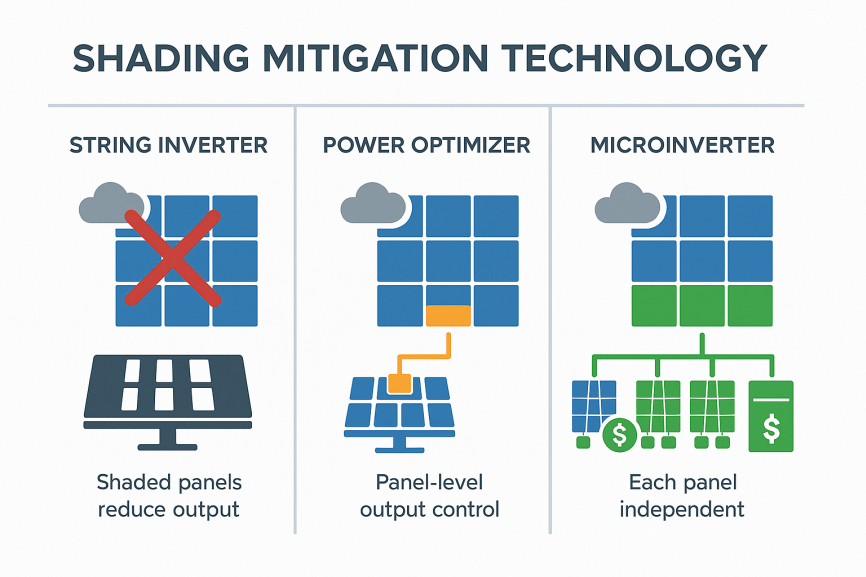Do Solar Panels Need Direct Sunlight? Sun vs Shade Guide (Massachusetts)
If you’ve ever wondered whether solar panels need direct sunlight to work, you’re not alone. It’s one of the most common questions homeowners ask when considering solar. The truth? Panels perform best in direct sun, but they can still generate electricity in cloudy conditions or even when partially shaded. The real difference comes down to how much energy is lost under shade — and that can affect your overall savings and payback period.
In this guide, we’ll break down the impact of direct sunlight vs shaded conditions on solar performance, how much efficiency you can expect to lose, and what modern technology can do to reduce those losses. Whether you’re comparing your sunny rooftop to one with a few trees, or simply want to understand how weather impacts solar, you’ll get clear answers here.
If you’re curious about how much solar panels cost in Massachusetts, check out this detailed guide.
How Solar Panels Generate Power – Sunlight vs Shade
At the simplest level, solar panels convert sunlight into electricity using photovoltaic (PV) cells. These cells are most efficient when they receive direct sunlight — the unobstructed rays of the sun hitting the panel at an optimal angle. This is when you’ll see maximum output, or close to the rated efficiency of your system.
But what happens when the sun isn’t shining directly? Even on cloudy days or in partial shade, panels can still capture diffuse light — sunlight scattered through clouds or bouncing off surfaces. While this allows your panels to keep producing, the energy output is noticeably lower than in full sun.
That’s why solar panel efficiency in sunlight is always higher than in shade. In fact, direct sunlight ensures each panel operates at peak capacity, while shaded conditions force the system to work harder for less return.
You can also compare this to your local solar cost and payback projections.
How Much Power Is Lost in Shade?

In full sun, a solar panel delivers close to 100% of its rated output. But introduce shade — whether from trees, chimneys, or nearby buildings — and that performance can drop significantly.
On average, partial shading can reduce panel output by 20–60%. For example:
- A single branch shading part of a panel might cut production by 25–30%.
- Heavier shading across multiple panels can lower efficiency by 50% or more.
- In worst-case scenarios with traditional string inverters, one shaded panel can drag down the entire string, creating system-wide losses.
Modern systems using microinverters or power optimizers help reduce this impact (we’ll cover that later), but it’s clear that solar shading efficiency loss is one of the biggest factors in system performance.
See this breakdown of real-world solar shading tests.
Experiment Examples – Real-Life Scenarios
Numbers always help put things into perspective. Multiple studies and field tests show how solar panels perform in real-world sunlight vs shaded conditions:
- Cloudy Days → Output often drops to 25–60% of normal capacity depending on cloud thickness.
- Partial Shade → When a tree branch or chimney shades part of a panel, efficiency can fall by 20–60%.
- Severe Obstruction → In cases where panels are almost fully shaded (like a roof under heavy tree cover), production can be nearly lost altogether.
Here’s a quick snapshot comparison:
| Condition | Expected Output vs Full Sun |
|---|---|
| Full Direct Sunlight | 100% (peak performance) |
| Cloudy Day | 25–60% |
| Partial Shade (tree/roof) | 40–80% |
| Severe Obstruction | <20% (sometimes near zero) |
These examples show just how much environment impacts production. While solar panels don’t need perfect sun every hour, shading can dramatically change your return on investment.
Curious how shading impacts solar savings in Massachusetts?
Why Shading Hits Output So Hard

One of the surprising things about solar panels is that even a small amount of shade can have an outsized impact. That’s because most panels are made up of multiple solar cells wired together in series. If just one of those cells is shaded, it can restrict the flow of electricity through the entire panel — like a kink in a garden hose. This is why the shading of a single cell can drag down the whole panel’s output.
To help manage this, most modern panels include bypass diodes. These components allow current to flow around shaded cells, reducing the loss. Still, when multiple cells are shaded, production can drop significantly. Without bypass protection, panels can even develop hot spots, where shaded cells overheat and damage the panel over time.
In short: shading is not just about losing a little sunlight — it’s about how the panel’s internal wiring responds to that shade. That’s why even small obstructions like twigs or leaves matter. Compare with Massachusetts solar installation tips for tricky rooftops.
Minimize Shade Loss – Tech & System Design

The good news? Modern technology offers several ways to reduce the impact of shading on solar panels. With the right system design, you can capture far more sunlight — even if your roof isn’t in perfect conditions.
1. Microinverters vs Power Optimizers vs String Inverters
- String Inverters → Least expensive, but one shaded panel can reduce output for the whole string.
- Power Optimizers → Installed at each panel, they adjust performance panel-by-panel, reducing shading losses.
- Microinverters → Convert DC to AC at each panel, giving maximum independence and the best solar shading solution for tricky roofs.
2. Using Half-Cut Cells
Many newer panels use half-cut cell technology, which splits cells into smaller sections. This reduces resistance and allows shaded areas to affect a smaller portion of the panel, keeping output higher.
3. Strategic Rooftop Layout
Experienced installers can design your system to minimize shading impact by:
- Avoiding roof sections with heavy shade.
- Positioning panels at optimal tilt/azimuth.
- Staggering strings so shaded areas affect fewer panels.
This kind of solar panel layout shading mitigation is especially important in areas with tall trees, chimneys, or complex rooflines.
Is Solar Still Worth It on a Shaded Roof?
The short answer: yes, solar can still be worth it even if your roof has some shade. While shading does reduce output, the combination of federal tax credits, Massachusetts state incentives, and the SMART Program can still make the numbers work in your favor. These incentives lower upfront costs and shorten payback periods — even if your panels aren’t in full sun all day.
Today, installers use advanced shading analysis tools (like Solar Pathfinder and digital apps) to predict exactly how much energy your roof can produce year-round. This means you’ll get a clear picture of your savings potential before you commit.
In Massachusetts especially, where electricity rates are high, even a partially shaded system can deliver strong long-term savings.
See how state incentives boost ROI.
✅ Ready to see what solar could look like for your home?
FAQs – Solar Panels: Direct Sunlight vs Shade
Q: Do solar panels require direct sunlight?
A: No, solar panels don’t require direct sunlight to work — they can also generate electricity from diffuse light on cloudy days. However, panels are most efficient in direct sun.
Q: How much output is lost in shade?
A: Depending on severity, shade can reduce solar panel output by 20–60%. With older string inverter systems, one shaded panel may lower production across the entire array.
Q: Can shaded homes still go solar?
A: Yes. Incentives and technology like microinverters and optimizers allow shaded homes to benefit from solar. Many Massachusetts homeowners with partial shade still see strong returns.
Q: What shading mitigation technology exists?
A: Solutions include microinverters, power optimizers, and half-cut cells, along with smart rooftop layouts to minimize shading impact.
Conclusion – Sunlight vs Shade: The Bottom Line for Homeowners
So, what’s the bottom line on solar panel direct sunlight vs shaded conditions? Direct sun will always deliver the highest efficiency and fastest payback. But shade doesn’t have to be a deal-breaker. With today’s technology — from microinverters to advanced panel designs — and strong incentives in Massachusetts, even partially shaded homes can benefit from solar.
The key is to get a proper shading analysis and work with a qualified installer who can design a system around your unique roof and surroundings.
✅ Ready to see what solar could save you? Contact us now.
